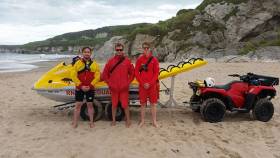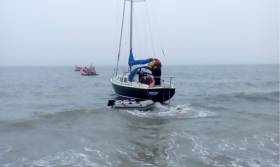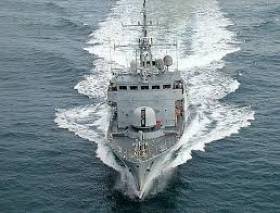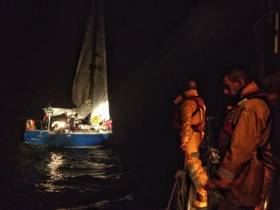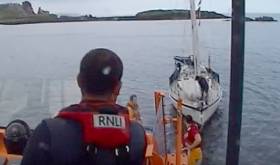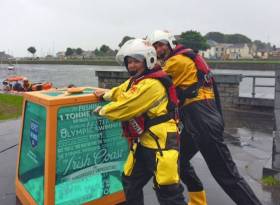Displaying items by tag: RNLI
Lough Derg RNLI Lifeboat Assist Seven people on 15–ft RIB
Lough Derg RNLI Lifeboat launched at 10.20pm yesterday evening to assist seven young people on board a 15ft–RIB (Rigid Inflatable Boat) with engine difficulties near Coolbawn Quay, on the eastern shore of Lough Derg.
Winds were westerly, Force 3, visibility was poor, with imminent nightfall.
At 10.30pm the lifeboat, with helm Peter Clarke, Eleanor Hooker and Keith Brennan on board, located the vessel by Illaunmor. The seven people on board were unharmed, but feeling chilled and were wrapped in towels. Survivor lifejackets were distributed to those who had none. An RNLI volunteer boarded the RIB and one of the casualties was taken onto the lifeboat. The lifeboat towed the RIB with her passengers to Dromineer.
Peter Clarke, Helm at Lough Derg RNLI Lifeboat, advises lake users to ‘respect the water, to carry enough lifejackets for everyone on board and to ensure they wear them, and to regularly service their boat’s engines’.
The Lifeboat returned to station and was ready for service again at 11.40pm
#RNLI - Fethard RNLI launched yesterday afternoon (Monday 18 July) for the second time in 24 hours, to a report of four people in difficulty due to dense fog at Woodstown Strand.
The Irish Coast Guard received a report that a party of four may have got into difficulty in the water as intense fog set in on the Co Waterford beach. The Fethard lifeboat launched from Duncannon in a light southerly Force 2 breeze with calm seas.
Arriving at Woodstown, the volunteer crew commenced a search north of the strand, incorporating a land search of the surrounding caves. Volunteer RNLI shore crew also attended at the strand and carried out search on the strand.
At 3.15pm, Fethard RNLI was stood down on notification from the Irish Coast Guard that all members were safely ashore and well.
Speaking following the callout, Fethard RNLI lifeboat helm Eoin Bird said: "We would like commend the member of the public who raised the alarm today when they were concerned.
"Our volunteers responded quickly this afternoon to aid in the search and we are delighted that all had been located safe and well."
Less than a day before the Fethard lifeboat was called out to assist a RIB with a fouled propeller off the strand, as previously reported on Afloat.ie.
In a dramatic rescue on Whiterocks beach at Portrush in County Antrim yesterday three RNLI lifeguards rescued two body boarders from rocks. In waves that reached well over head height the lifeguards launched their Rescue Water Craft and brought the two men to safety. The rescue occurred during one of the hottest days of the year which brought hundreds of people to the coast to enjoy the good weather.
The alarm was raised at 4.30pm when a member of the public contacted RNLI Lifeguard Stephen Parish to say that two body boarders where trapped at the mouth of a cave at the east end of the beach. Steven and his two colleagues on duty, Ali Boyd and Bosco McAuley, were finishing an exercise when the call for help was made and they immediately swung into action.
RNLI lifeguard Ali Boyd drove the Rescue Water Craft while Bosco McAuley accompanied him as crew. They proceeded to the scene some 500 metres offshore where a heavy swell made it impossible to bring the rescue craft close to the trapped pair. With the waves breaking over the men’s heads, the lifeguards waited until there was a lull in the set before Bosco jumped into the water and swam to the rocks. The first man went into the water and was brought by Bosco to the waiting rescue craft. The three of them immediately returned to shore before the two lifeguards headed straight back to the scene to recover the second casualty.
By this time the second man was showing signs of exhaustion and the lifeguards kept a tight hold of him as they recovered him, with Bosco once again swimming out to him while Ali kept the rescue water craft close-by, circling to ensure he stayed clear of the waves and avoided the rocks.
When back on shore both men were brought to the Lifeguard hut and were administered casualty care.
Commenting on the callout RNLI lifeguard Bosco McAuley said, ‘It was a busy day on the beach yesterday and we are always conscious that there can be things happening anywhere at anytime. We had just finished an exercise and were able to launch the Rescue Water Craft immediately. Despite the warm day, the sea swell was huge with massive waves breaking over the heads of the body boarders as they waited on rocks. They had managed to scramble on these rocks when they got into difficulty and were able to wait for help. This was a rescue where every second counted and thankfully these two men are now home safe and well.’
#RNLI - A major search was mounted on the south coast between Crosshaven and Kinsale on Friday (15 July) after a lone yachtsman broadcast a Mayday call that he was on the rocks at the Little Sovereign Rock.
Lifeboat pagers were activated at 12.07pm and both Crosshaven and Kinsale RNLI headed to the location, joined by Crosshaven Coast Guard and the Waterford-based Irish Coast Guard helicopter Rescue 117.
Conditions were poor on scene, with a fog reducing visibility to just 200m. Kinsale RNLI found no trace of the yacht at the Sovereigns, while Crosshaven RNLI searched the shore from Roberts Head west. Crosshaven Coast Guard stood offshore as a radio relay to Valentia Coast Guard.
The Crosshaven lifeboat crew eventually located the vessel aground in Rocky Bay. One crewmember swam to the yacht with a towline and retrieved the its anchor and line. The yacht was then refloated and towed into deeper water.
After handing off the tow to Kinsale RNLI, the vessel and its yachtsman were returned to Oysterhaven none the worse for wear.
Fethard Lifeboat Launches To RIB With Fouled Propeller
#RNLI - Fethard RNLI's inshore lifeboat Tradewinds launched yesterday afternoon (Sunday 17 July) to a 6m RIB with a fouled propeller off Woodstown Strand in Waterford.
The RIB got into difficulty when its propeller became entangled in mussel cages within the shellfish bed area off of Woodstown Strand, leaving it stranded.
There was six people, four male and two female, on board the RIB, all of whom were wearing lifejackets.
The Fethard lifeboat launched from Duncannon, with good weather and a south-westerly wind of Force 2-3, and arrived with the casualties at 4pm.
The volunteer lifeboat crew were required to take some passengers off the RIB to help propel the craft up and enable them successfully to release the propeller from the mussel cages.
Once released, the RIB was towed by the lifeboat to deep water where its engine was restarted. The lifeboat then accompanied the RIB back to Dunmore East.
Speaking following the callout, Fethard RNLI deputy launching authority Tony Molloy said: "The casualties did the right thing in calling for assistance. They did not panic, stayed clam and all members were wearing lifejackets.
"The RNLI crew were on scene swiftly prior to high tide due at 5pm, therefore there was no imminent danger or any requirement for the casualties to abandon their RIB."
Molloy added: "It is important to watch out for safety markers off of our coastline, as such help notify boaters of potential hazards.
"In this instance they had VHF and prior to launching had determined the best course of action to take if they were to get into trouble.'
Two days previously Fethard RNLI launched to a 21-foot lobster boat with a fouled propeller one mile from Baginbun Head.
The volunteer lifeboat crew were able to release the rope and the fishing vessel, with one on board, returned to Fethard Dock under its own steam.
In other Fethard lifeboat news, funds will be raised for the long-running lifeboat station at the inaugural Waves Music Festival next month, as previously reported on Afloat.ie.
CoastGuard IMSARC Demo a Success Off Donegal
The Irish Coast Guard co-ordinated a very successful Marine Search and Rescue demonstration yesterday, Saturday 16th July. As Afloat.ie reported previously, the exercise in Moville Co Donegal involved some of Ireland’s principal Search and Rescue resources. Participants included Donegal based volunteer Coast Guard units, the Sligo based Coast Guard Rescue Helicopter, Naval ship LÉ Orla, Air Corps Casa, RNLI’s new Shannon Class All Weather Lifeboat, Bord Iascaigh Mhara, UK Maritime Coastguard Agency, Irish Water Safety, Mountain Rescue Ireland and the Civil Defence.
Speaking after the event Gerard O’Flynn, the Coast Guard’s Search and Rescue Operations Manager said: ‘This exercise afforded the public a wonderful opportunity to see Ireland’s search and rescue resources conducting a series a realistic but challenging tasks, more importantly it enabled the Coast Guard to exercise interoperability between the different assets.”
The event included a series of water based safety demonstrations.
“Prevention and adherence to basic safety is the key element in minimising loss of life at sea and on our waterways”, concluded SARs Manager Gerard O’Flynn.
The main events:
Mud rescue demonstration by nearby members of the Maritime Coastguard Agency, Bay Field in the low water river bed.
The Donegal Mountain Rescue team along with their colleagues in the Civil Defence also at Bay Field displayed their new Drone
Greencastle Coast Guard unit executed a number of cliff rescue displays.
Rescue 115, the Sligo based rescue helicopter along with the crew of LÉ Orla completed a number of winching exercise. From the deck of LÉ Orla and a “wet” lift.
The Air Corps Casa demonstrated the use of airborne life rafts as well as conducting communications exercises with air and surface resources.
Over the course of the day, Volunteer Coast Guard units from Donegal, Mulroy, Killybegs, Greencastle and Bunbeg completed number of rescue manoeuvres including - man over board, swimmer/paddle board in difficult, fishing vessel on fire.
Dunmore East RNLI Assists Yacht With Fouled Sails
#RNLI - Dunmore East RNLI's lifeboat crew launched in the early hours of yesterday morning (Saturday 16 July) to assist a 38ft yacht with four people on board.
The sailing vessel, half a mile east of Dunmore East Harbour, had fouled its sails and could not lower them to enter the harbour.
Minutes after launch at 2.20am, the Trent class lifeboat Elizabeth and Ronald arrived on scene to find the sailing vessel with its sails up and fouled. The vessel found it difficult to keep a heading and crew on board could not lower the sails.
The lifeboat came alongside the yacht and two volunteers boarded the yacht to help fix the issue and lower the sails so the yacht could make its way under power to the harbour.
Escorted by the Dunmore East lifeboat, they yacht reached the safety of the harbour at 3:15am.
Dunmore East RNLI coxswain Michael Griffin said: "The crew of the yacht made the right call; visibility was poor at the time and the outcome could have been a lot worse.
"Our two crew, who went on board the yacht, did a great job in sorting out the sails and lowering them so quickly."
Donaghadee RNLI Rescues Stricken Yacht As Darkness Falls
#RNLI - Donaghadee RNLI's lifeboat crew saved a stricken yacht with one person onboard after it was left helpless in poor weather off the coast of Millisle, Co Down.
Donaghadee lifeboat Saxon and her volunteer crew sped to the last reported position of the vessel at top speed of 25 knots after a launch request from the coastguard at 9.30pm on Friday evening (15 July).
A strong south-westerly wind was blowing with rain forecast, and night was falling as the lifeboat crew searched before locating the yacht two miles offshore. No radio contact was possible.
A towline was quickly attached and the yacht brought to Donaghadee Harbour for inspection and repairs.
It was the lifeboat’s second launch of the week. Last Sunday evening (10 July) Saxon and crew put to sea in response to a man overboard alert in Ballyhalbert after a pleasure sailor fell from his boat and was unable to get back aboard.
However, the casualty was assisted by another vessel and was able to make his way ashore uninjured.
Donaghadee RNLI coxswain Philip McNamara said: "We are always happy to launch if there is a chance we can prevent an emergency or save a life at sea. But everyone enjoying the coast this summer should respect the water and wear lifejackets when around deep water.
"If you are boating make sure you have a reliable means of contacting the shore and of calling for help."
Howth RNLI Rescue Yacht Aground with 7 People Onboard
Howth RNLI launched at 1.15pm Thursday 14th July 2016 to reports of Sailing Yacht with 4 adults and 3 children aground just off Ireland Eye.
The casualty vessel was quickly located and towed to safety.
The request to launch came at 1.15pm and the Howth RNLI all-weather lifeboat proceeded outside the harbour and quickly located the yacht aground in Howth sound. The 32ft Sailing yacht had 4 adults and 3 children aboard. All were wearing lifejackets.
Weather was excellent with overcast clouds but good visibility. The sea state was calm with little or no wind present. The tide was quite low with another hour to go to low tide.
Howth RNLI volunteers Fin Goggin and Stephen Mullaney threw a tow line to the casualty vessel which was then secured and Howth RNLI Coxswain Fred Connolly used his driving skills to safely tow the casualty vessel off the rocks with little or no damage. When clear the sailing yacht was able to make its own way back to Howth Harbour.
Howth RNLI Lifeboat Operations Manager Colm Newport says: ‘A quick call was made by the skipper of the yacht as soon as he got into difficulty which showed good seamanship. These things happen and we were delighted to be able to assist.”
#RespectTheWater - The RNLI has placed a tonne of water in Galway and Dun Laoghaire respectively for the summer months in a bid to show visitors and locals alike the power of the water, river and sea.
The tonnes of water, which will be located at the Spanish Arch in Galway and Dun Laoghaire's East Pier until the end of August, forms part of the RNLI’s Respect The Water campaign.
Each tonne is printed with important advice about the power of water, such as how fast a rip current can flow. They will also demonstrate to people how heavy a relatively small volume of water is – one cubic metre of water weighs one tonne.
They were created to be a visual and engaging way of delivering this message that no matter how strong a swimmer you might be, you are no match for the power of the water.
Last month the RNLI launched its annual national drowning prevention campaign, Respect The Water, and this year the charity is warning the public to watch out for key dangers that can catch people out in or near water.































